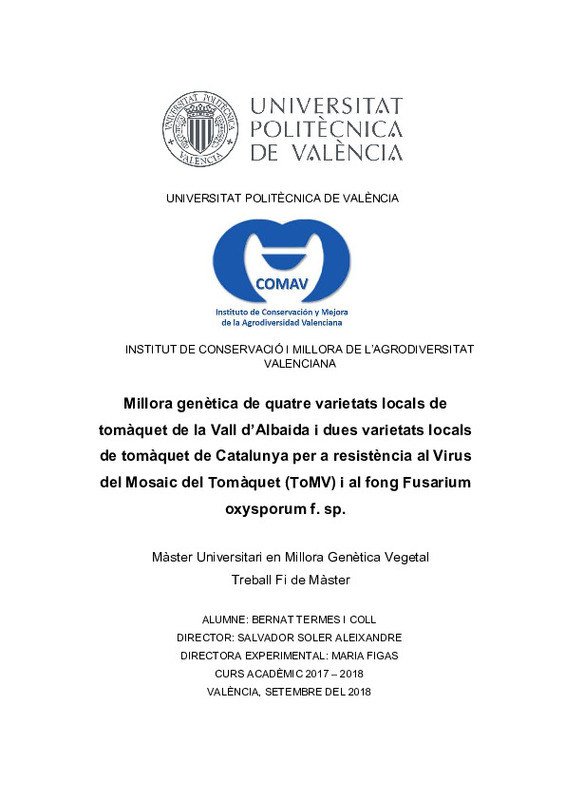|
Resumen:
|
L'interès dels consumidors per la varietats locals de tomàquet (Solanum lycopersicum L.) està en augment. Una de les causes d'aquesta recent apreciació, recau en les propietats organolèptiques d'aquest tipus de materials. ...[+]
L'interès dels consumidors per la varietats locals de tomàquet (Solanum lycopersicum L.) està en augment. Una de les causes d'aquesta recent apreciació, recau en les propietats organolèptiques d'aquest tipus de materials. A les regions on es practica una agricultura d'alts inputs, les varietats locals han sofert un procés de marginació, incitat principalment per les diferències de rendiment respecte a les varietats comercials. Donat l'important interès mundial per la conservació de la biodiversitat, conjuntament amb l'estima pel consumidor, cal l'estudi d'aquestes varietats i evitar la desaparició. A la península ibèrica, centre d'alta variabilitat de l'espècie conreada de tomàquet, hi ha nombroses varietats locals. L'actual sistema d'agricultura intensiva juntament amb la variació del clima, i una intensa globalització dels mercats mundials, ha agreujat els problemes ocasionats per plagues i malalties en les varietats locals. Justament aquest tipus de varietats no han estat seleccionades per la resistència a malalties i plagues, especialment les d'origen forani. En l'actual projecte de millora, es pretén abordar l'objectiu de millorar sis varietats locals, quatre d'elles de València i dues varietats de Catalunya, per conferir-resistència al virus de la ToMV i a Fusarium. Com portadors i donants dels gens de resistència, s'han utilitzat tres parentals, buscant la millor complementarietat de propietats morfològiques amb el parental recurrent. El mètode de millora que s'ha emprat ha estat un retrocreuament bàsic sense modificacions durant tres cicles. S'ha utilitzat la selecció per marcadors moleculars per identificar els individus portadors del gen de resistència. A cada generació, s'han fenotipat les plantes per veure la similitud i diferència al fenotip de la varietat local. Així, s'han seleccionat com plantes a retrocreuar aquelles més semblants al fenotip original. La caracterització del fruit, s'ha realitzat mitjançant el programari d'anàlisi d'imatge Tomato Analyzer que facilita el procés i incrementa el nombre de caràcters a estudiar. Això permet una selecció més eficaç i objectiva de les millors plantes donants amb alta similitud a l idiotip de la varietat local. Actualment s'ha realitzat l'encreuament inicial i el primer i segon retrocreuament.
[-]
The interest of the consumers for the local varieties of tomato (Solanum lycopersicum L.) is in increasing. One of the causes of this recent appreciation lies in the organoleptic properties of this material. In regions ...[+]
The interest of the consumers for the local varieties of tomato (Solanum lycopersicum L.) is in increasing. One of the causes of this recent appreciation lies in the organoleptic properties of this material. In regions where high-input agriculture is practiced, local varieties have suffered a process of marginalization, prompted mainly by differences in yield with respect to commercial varieties. Given the important global interest for the conservation of biodiversity, together with the appreciation for the consumer, it is necessary to study these varieties and avoid their disappearance. In the Iberian Peninsula, center of high variability of the cultivated tomato, there are numerous local varieties. The current system of intensive agriculture along with the variation of climate, and an intense globalization of world markets, has aggravated the problems caused by pests and diseases in local varieties. This type of varieties have not been selected for resistance to diseases and pests, especially those of foreign origin. In the current improvement project, the aim is to improve six local varieties, four of them from Valencia and two varieties from Catalonia, to confer resistance to the ToMV virus and Fusarium. As donors of the resistance genes, three parentals have been used, seeking the best complementarity of morphological properties with the recurrent parent. The improvement method that has been used has been a basic backcross without modifications during three cycles. Selection by molecular markers has been used to identify individuals carrying the resistance gene. In each generation, the plants have been phenotyped to see the similarity and difference to the phenotype of the local variety. Therefore, plants that resemble the original phenotype have been selected as backcrossing plants. The characterization of the fruit has been carried out using the Tomato Analyzer image analysis software that facilitates the process and increases the number of characters to be studied. This allows a more effective and objective selection of the best donor plants with high similarity to the idiotype of the local variety. The initial crossing and the first and second backcrosses have been made.
[-]
|







